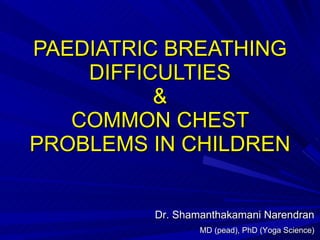
Makalla swashakoshada tondare
- 1. PAEDIATRIC BREATHING DIFFICULTIES & COMMON CHEST PROBLEMS IN CHILDREN Dr. Shamanthakamani Narendran MD (pead), PhD (Yoga Science)
- 24. Treatment of acute asthma in children aged >2 years Thorax 2003; 58 (Suppl I): i1-i92 * Dose can be repeated every 20-30 minutes IV salbutamol (15 m g/kg) is effective adjunct in severe cases B Individualise drug dosing according to severity and adjust according to response B pMDI and spacer are preferred delivery system in mild to moderate asthma A Inhaled ß 2 agonists are first line treatment for acute asthma * A Use structured care protocols detailing bronchodilator usage, clinical assessment, and specific criteria for safe discharge D Children with life threatening asthma or SpO 2 <92% should receive high flow oxygen via a tight fitting face mask or nasal cannula at sufficient flow rates to achieve normal saturations
- 26. Other therapies for acute asthma in children aged >2 years Thorax 2003; 58 (Suppl I): i1-i92 * Dose can be repeated every 20-30 minutes If poor response to 2 agonist treatment, add nebulised ipratropium bromide (250 mcg /dose mixed with 2 agonist) * A Aminophylline is not recommended in children with mild to moderate acute asthma A ECG monitoring is mandatory for all intravenous treatments Consider aminophylline for children in high dependency/intensive care with severe or life threatening bronchospasm unresponsive to maximal doses of bronchodilators and steroid tablets C Do not give antibiotics routinely in the management of acute childhood asthma
- 27. Hospital admission for acute asthma in children aged >2 years Thorax 2003; 58 (Suppl I): i1-i92 Consider intensive inpatient treatment for children with SpO 2 <92% on air after initial bronchodilator treatment B Decisions about admission should be made by trained physicians after repeated assessment of the response to further bronchodilator treatment Transfer children with severe or life threatening asthma urgently to hospital to receive frequent doses of nebulised 2 agonists (2.5-5mg salbutamol or 5-10 mg terbutaline) Children with acute asthma failing to improve after 10 puffs of 2 agonist should be referred to hospital. Further doses of bronchodilator should be given as necessary whilst awaiting transfer Treat with oxygen and nebulised 2 agonists during the journey to hospital
- 28. Treatment of acute asthma in children aged <2 years Thorax 2003; 58 (Suppl I): i1-i92 Oral 2 agonists are not recommended for acute asthma in infants B For mild to moderate acute asthma, a pMDI with spacer is the optimal drug delivery device A Consider inhaled ipratropium bromide in combination with an inhaled 2 agonist for more severe symptoms B Consider steroid tablets in infants early in the management of moderate to severe episodes of acute asthma in the hospital setting C Steroid tablet therapy (10 mg of soluble prednisolone for up to 3 days) is the preferred steroid preparation
